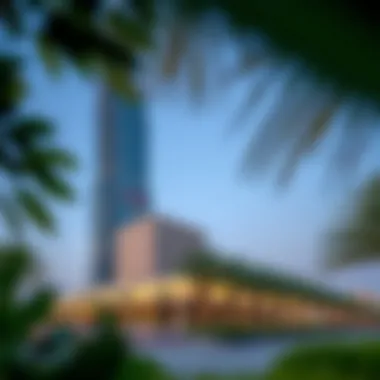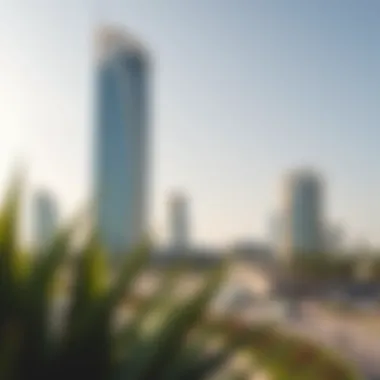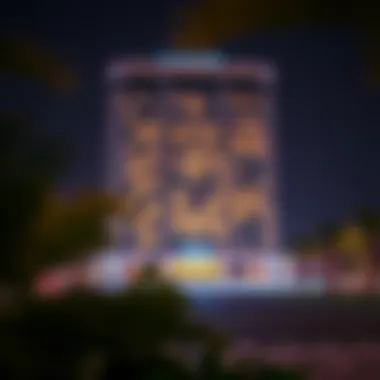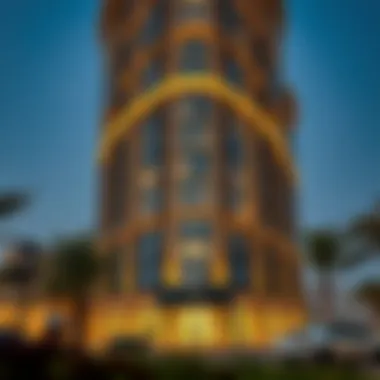The Liwa Building: Significance in Dubai's Real Estate


Intro
In the heart of Dubai's shifting skyline, the Liwa Building emerges as a significant structure, representing more than just bricks and concrete. This article takes a closer look at the multifaceted role the Liwa Building plays in the city's real estate landscape. By exploring its architectural intricacies, historical backdrop, and socio-economic impact, we aim to paint a vivid picture of why this building is of utmost importance. As one of the many jewels adorning the urban fabric of Dubai, the Liwa Building offers promising investment opportunities and insights into the future of the real estate market.
With the dynamic nature of Dubai's property landscape, understanding the implications of structures like the Liwa Building can bolster the decision-making process for investors, buyers, and real estate professionals alike.
Market Trends and Analysis
Recent Market Performance
The Liwa Building is not just a structure; it reflects trends in the broader Dubai property market. Over the past few years, the Dubai real estate sector has seen fluctuations driven by various factors including economic reforms, Expo 2020 hype, and shifting consumer demands. The Liwa Building has maintained a steady demand due to its strategic location and modern amenities.
- Demand Drivers:
- Proximity to key business districts.
- Availability of residential and commercial spaces within the building.
- A growing population looking for housing options.
Real estate agents have noted a surge in interest not only from local buyers but also from international investors keen on partaking in Dubai’s booming market. Data suggests that properties in this area regularly see appreciation rates that outpace the national average, which could indicate a solid investment opportunity for those in the know.
Future Projections and Opportunities
Looking ahead, the Liwa Building stands poised to benefit from several forecasted market trends. Expect to see:
- Continued Urban Development: The area surrounding the Liwa Building is being targeted for further infrastructure enhancements, improving access and livability.
- Sustainability Initiatives: With global emphasis on green buildings, the Liwa Building may adopt eco-friendly practices in renovation, which could enhance its market value.
- Diversification of Real Estate Offerings: As the property market diversifies, new configurations and uses for existing buildings will emerge, potentially increasing demand for leasing offices and retail spaces within.
Investors are advised to keep a keen eye on how these dynamics evolve, as they may uncover rich opportunities tied to this building's significance in the overarching real estate narrative of Dubai.
Investment Strategies
Understanding Property Valuation
For investors eyeing the Liwa Building, comprehending property valuation is key. Properties in Dubai are typically appraised based on:
- Location and Accessibility: How easily can tenants and customers reach the property?
- Market Comparables: How do similar properties in the area perform?
- Property Condition and Amenities: What upgrades or unique features does the building offer?
This understanding allows potential buyers to approach negotiations with a more informed perspective, which could be the difference between landing a deal that’s a steal and one that’s a bit overpriced.
Navigating Legal Considerations
Investing in real estate in Dubai can also be a landscape lined with legal nuances. Those looking to purchase or lease within the Liwa Building should consider:
- Ownership Regulations: Depending on the buyer residency status, ownership terms can differ greatly.
- Regulatory Framework: Familiarizing with RERA’s (Real Estate Regulatory Agency) regulations is crucial for smooth transactions.
- Lease Agreements: Understanding the fine print in lease agreements can spare investors from potential pitfalls in the future.
"Investors need to stay informed about legal frameworks to ensure a hassle-free experience in Dubai’s property market."
For more insights on Dubai's real estate trends, visit Dubai Land Department's official site. You can also explore investment opportunities on sites such as realtor.com.
Preface to the Liwa Building
In the sprawling metropolis of Dubai, the Liwa Building stands as a testament to the city's ambitious real estate landscape. This section sets the stage for a deeper exploration of the significance and influence the Liwa Building holds within the urban fabric of Dubai. Understanding this structure is pivotal not only for investors and developers, but also for anyone keen on the local economy and urban development trends.


Overview of Liwa Building
The Liwa Building, located in a prime area of Dubai, is more than just concrete and glass; it’s a reflection of innovative architectural design and strategic urban planning. Completed in [insert year], this building embodies a blend of modern aesthetics and functionality. Characterized by its sleek lines and striking facade, the Liwa Building has become an identifiable part of the skyline.
This structure isn't merely about beauty; it plays a vital role in providing commercial space to businesses and enhancing the urban landscape. The Liwa Building offers flexible office spaces that cater to various companies, from start-ups to established corporations. Its design promotes an environment conducive to both creativity and productivity.
Furthermore, the functional aspects of this building, equipped with state-of-the-art facilities, contribute significantly to its appeal. The generous square footage and arrangements allow companies to thrive in a competitive market, making the Liwa Building an attractive destination for business operations.
Importance in Dubai's Urban Development
The Liwa Building is a keystone in the broader narrative of Dubai's rapid urban development. As the city seeks to establish itself as a global hub for commerce and tourism, structures like the Liwa Building are crucial in achieving these ambitious goals.
- Catalyst for Growth: The building aids in urban regeneration efforts, helping transform previously underdeveloped areas into bustling centers of activity.
- Infrastructure Improvement: Its existence necessitates improvements to surrounding infrastructure, including transportation networks, which is beneficial for the entire community.
- Economic Stimulation: By attracting businesses, it contributes to job creation and increased economic activity, thereby lifting the overall economic prospects of the region.
Furthermore, the Liwa Building serves as a model for future developments in Dubai. With its emphasis on sustainability and modern design, it sets a benchmark for how infrastructure can evolve in tandem with environmental considerations.
"The Liwa Building is not just a structure; it's a landmark of progress in Dubai's ongoing story of growth and transformation."
Thus, the Liwa Building plays a dual role: it not only provides essential economic functionality but also contributes to the aesthetic and cultural evolution of Dubai’s urban landscape. This ambitious framework for development positions the Liwa Building as a pivotal player in the city's future.
Architectural Features of the Liwa Building
The architectural features of the Liwa Building play a crucial role in understanding not only its aesthetic appeal but also its practical contributions to the urban landscape of Dubai. The design encapsulates local culture while reaching for modern functionality, making it a notable example in the bustling heart of Dubai's real estate market. The building’s unique characteristics are interwoven with both tradition and innovation, and they reflect a broader movement towards integrated urban design in the region.
Design Philosophy
The design philosophy behind the Liwa Building is about harmonizing contemporary architectural practices with local heritage. The façade combines traditional elements, such as intricate masonry patterns reminiscent of the region's historic buildings, with glass and steel components that symbolize Dubai's modern skyscraper culture. This juxtaposition not only captures the essence of Dubai’s progression but also creates an inviting silhouette that blends into the city’s skyline.
The architects aimed for a layout that emphasizes open space, allowing natural light to penetrate deep into the building. This transparency creates an uplifting atmosphere conducive to both work and social collaboration. The building encourages a flow of interaction among its tenants, fostering a sense of community which is often lacking in more modular developments.
Materials and Construction Techniques
When it comes to materials and construction techniques, the Liwa Building stands out as a pillar of modern engineering. Utilizing locally sourced materials, the construction process underscores sustainability by minimizing the carbon footprint. The exterior features high-performance glass capable of reflecting heat while allowing ample sunlight, thereby reducing energy costs for air conditioning.
Notably, the use of reinforced concrete ensures both structural integrity and durability, allowing the building to withstand the harsh desert climate. The craftsmanship evident in the various decorative elements showcases skilled labor, marrying traditional artisan techniques with contemporary design aesthetics. This blend not only showcases the potential of modern construction but also supports the local economy by providing jobs within the community.
Innovations in Sustainability
Sustainability is at the heart of the Liwa Building’s design. Among its innovative elements, the incorporation of solar panels on the roof illustrates a commitment to renewable energy. This technology not only powers common areas but significantly lowers utility costs for tenants. The building also features a rainwater harvesting system that reuses water for irrigation, effectively treating and recycling resources.
"Sustainable architecture is not just an afterthought; it is integral to the identity of the Liwa Building, offering a blueprint for future developments in Dubai."
Additionally, smart building technologies have been integrated to enhance operational efficiency. These systems allow for real-time monitoring of energy usage, ensuring that the building not only meets but exceeds environmental standards. The combination of such advanced features positions the Liwa Building as a leader in eco-friendly design within Dubai’s emerging real estate landscape.
Historical Context of the Liwa Building
Understanding the historical context of the Liwa Building is crucial for anyone looking to navigate the intricacies of Dubai's real estate landscape. The Liwa Building is not just an impressive physical structure; it embodies the rapid transformation that Dubai has experienced over the last few decades. This section examines the timeline of development and the cultural significance of the Liwa Building, offering a lens through which investors and developers can decipher both the past and future of real estate in this dynamic city.
Timeline of Development
The evolution of the Liwa Building mirrors Dubai's ambition and drive towards modernization. Construction began in the early 2000s, during a period when Dubai was attracting global attention as a hub for commerce and tourism. Here’s a brief timeline to encapsulate its development phases:


- 2001: Foundations laid. Initial designs highlight both modern and traditional elements, aiming to blend the old with the new.
- 2004: Structural framing completed, marking a significant milestone. This was a period of rapid growth as more infrastructure projects flourished nearby.
- 2007: Completion of construction. The building not only showcases architectural prowess but symbolizes Dubai's surge as a global city.
- 2010: Official opening ceremony, lauded by officials as a hallmark of economic progress in the region.
This chronology illustrates how the Liwa Building serves as a touchstone for broader urban development, influencing not just real estate but also improving local amenities. Its timing coincided with significant infrastructural investments, making it a beacon in a transforming landscape.
Cultural Significance
The cultural importance of the Liwa Building cannot be overstated. It sits at a crossroads of tradition and innovation, reflecting Dubai's unique identity. Its architectural style integrates elements from traditional Emirati culture while adopting cutting-edge construction methods. Emphasizing local heritage, the building incorporates features reminiscent of local markets, known as "souks," providing a nod to the city’s deep-rooted trading history.
Additionally, the Liwa Building serves as a center for various community activities and corporate events. This makes it not only a place for businesses but also a venue for cultural gatherings, fostering a sense of community and belonging among residents and expatriates.
"The Liwa Building stands as a testament to Dubai's journey into a new era, bridging its rich past with a vibrant future."
Liwa Building and Socio-economic Impacts
The Liwa Building stands as a crucial icon in Dubai's rapidly changing real estate landscape. It doesn't just represent a static structure; it embodies a dynamic interplay between urban development and socio-economic vitality. Understanding the socio-economic impacts associated with the Liwa Building helps in grasping how this building not only contributes to the skyline but also to the community's fabric. The significance of this topic is multifaceted, touching on urban regeneration, local economies, and overall development strategies.
Urban Regeneration Initiatives
Urban regeneration is a key aspect in which the Liwa Building plays a vital role. The area around the building has seen considerable transformations aimed at revitalizing old neighborhoods while attracting new businesses and residents. The local government and private developers recognized that a modern architectural marvel like the Liwa Building could drive further investments and enthusiasm in the vicinity.
As a result, several initiatives have emerged:
- Landscaping and Green Spaces: Nearby parks and public areas have been enhanced to create inviting environments, promoting community interaction and outdoor activities.
- Infrastructure Upgrades: Major roadways and public transport systems have been developed to complement the increased foot traffic, making commute easier for workers and residents alike.
- Cultural Programs: Events held at or near the Liwa Building have encouraged local arts and crafts, fostering community pride and engagement.
These initiatives not only elevate the aesthetics of the area but also create a ripple effect on the local economy and environment. The building serves as a catalyst, pushing both public and private entities to invest in shared goals.
Effects on Local Economy
The Liwa Building's influence on the local economy embodies a classic case of symbiosis, where the construction and ongoing operations of the building enhance economic conditions while being nurtured by them. Let’s unpack some crucial elements about its economic impact:
- Job Creation: The construction and subsequent operation of the Liwa Building generate numerous job opportunities, from skilled labor during construction, to administrative and service jobs once the building is operational. These jobs not only support families but also contribute to higher spending in the local economy.
- Increased Property Values: With the rise of the Liwa Building, neighboring property values have surged. Investors are attracted to the region, leading to stronger demand for housing and commercial spaces.
- Business Growth: Local businesses, especially retail and hospitality, benefit from increased foot traffic. The presence of the Liwa Building draws in residents, tourists, and business professionals, leading to greater sales and expanded services.
"The Liwa Building signifies more than just innovative design; it merges economic growth with urban living, fostering a community around commercial vitality."
For further insights on urban development and investment potential, consider exploring resources such as Wikipeda, Britannica, and economic reports from governmental sources like UAE Government.
Understanding the Liwa Building and its socio-economic impacts provides essential context for making informed decisions in Dubai's real estate marketplace.
Investment Opportunities Associated with Liwa Building
Investment opportunities tied to the Liwa Building serve as a vital component in understanding the complexities and potential of Dubai's real estate landscape. As a rising star in the urban skyline, the Liwa Building provides various prospects for local and international investors, property developers, and real estate agents. This section will explore current real estate trends and projections for future growth, emphasizing how involvement with this striking structure can yield notable returns.
Current Real Estate Trends
The real estate sector in Dubai is continuously evolving, reflecting the shifting needs and preferences of its diverse population. Current trends indicate a marked interest in properties that combine luxury with strategic positioning. The Liwa Building, prominently located, offers more than just residential spaces.
- High Demand for Mixed-Use Developments: As urban environments become increasingly integrated, buyers and renters show preference for living spaces that combine residential units with commercial opportunities. The Liwa Building reflects this trend with its mix of apartments and business setups.
- Sustainability Factors: More buyers are looking for eco-friendly and energy-efficient properties. The Liwa Building’s commitment to innovative sustainability practices can attract environmentally conscious investors, elevating its appeal in the marketplace.
- Government Initiatives: Dubai's government has been actively promoting investments in areas like real estate. Schemes to ease ownership regulations for expatriates further enhance the market's attractiveness, benefiting developments like the Liwa Building.
"Investors are increasingly gravitating towards properties that not only promise luxury but also sustainability and community integration. The Liwa Building captures these essentials beautifully."


Forecast for the Future
Looking ahead, the Liwa Building is poised to play a critical role in shaping future investment landscapes in Dubai. Evaluating forthcoming trends can provide investors the insights needed to make informed decisions:
- Continued Growth in Demand: The rise in population and influx of expatriates will lead to sustained demand for housing. With its strategic location, the Liwa Building is expected to enjoy high occupancy rates.
- Emerging Tech Hubs: The anticipated growth of technology and innovation districts in Dubai can drive commercial interest in adjacent areas. The Liwa Building’s proximity to potential future tech hubs positions it as an attractive option for those looking to invest in both residential and commercial spaces.
- Market Recovery Post-Pandemic: As the world economy rebounds from the pandemic, analysts predict a surge in investments in luxury real estate. The Liwa Building is anticipated to benefit from this resurgence, potentially offering robust returns for investors who get in early.
In summary, the Liwa Building encompasses many key elements that are attractive to today’s investors. From evolving market trends to promising forecasts, engaging with this iconic structure presents a chance to be part of Dubai's future development story, while capitalizing on the benefits it provides.
Challenges and Considerations
The exploration of the Liwa Building in the context of Dubai's real estate landscape necessitates a close examination of the challenges and considerations inherent to such a monumental structure. Understanding these facets is not just critical for scholars and enthusiasts but also for investors, agents, developers, and potential buyers. Alongside the grandeur and significance of the Liwa Building, the market's dynamics and regulatory frameworks pose various considerations that could affect real estate strategies and investment decisions.
Market Fluctuations
Market fluctuations in real estate represent a double-edged sword, wielding the power to elevate or undermine property values. For the Liwa Building, positioned in a rapidly evolving environment, these fluctuations can be particularly pronounced. In recent years, Dubai has seen its property market ride a volatile wave – from booming highs to significant lows – often influenced by external economic factors, domestic policies, and regional geopolitical stability.
One moment you might feel like a king in the bustling markets of Dubai, and the next, a rain cloud could hover over property values. Here are a few pivotal factors to consider when discussing market fluctuations:
- Economic Indicators: Fluctuations in the global economy can greatly impact investor confidence. Economic downturns tend to decrease demand for luxury properties, which may affect the Liwa Building's perceived value.
- Supply and Demand: The balance between supply and demand directly impacts pricing. As new properties are developed in the vicinity, this can influence the attractiveness of established buildings like Liwa.
- Investor Sentiment: With speculation often driving real estate values, understanding current sentiment can provide insights into potential future fluctuations.
In essence, addressing market fluctuations necessitates a keen awareness of local and global economic climates, alongside a thorough analysis of current real estate trends.
Regulatory Constraints
Another critical consideration when it comes to the Liwa Building is the regulatory environment within the UAE, particularly concerning real estate transactions. Navigating these regulations is akin to steering a ship through known treacherous waters; one can steer oneself to a safe harbor if adequately informed.
Understanding government policies and regulations is essential for potential investors and stakeholders. Some of the key regulatory constraints include:
- Building Codes and Regulations: Compliance with safety standards, zoning laws, and environmental regulations can affect development plans significantly. These codes are designed for safety and sustainability but might pose hurdles for renovation or expansion of the Liwa Building.
- Ownership Laws: Foreign ownership laws in Dubai can present challenges. Investors need to understand the areas where foreign ownership is allowed and how this may impact their investment strategy regarding the Liwa Building.
- Licensing Requirements: Engaging in real estate transactions often requires navigating a bureaucratic web of licensing and permits. Adequate understanding of these requirements is essential for a smooth transaction process.
In summary, grappling with regulatory constraints can be daunting, but an informed approach that underscores awareness and preparation can mitigate risks and help investors make astute decisions concerning the Liwa Building.
"Investing in real estate is more than just numbers - it's about understanding the ever-changing landscape that influences every decision. The Liwa Building, while a beacon of opportunity, is not without its complexities."
The Liwa Building stands as a critical component of Dubai’s architectural and socio-economic fabric, but acknowledgment of these challenges allows stakeholders to navigate the landscape prudently, ensuring that their investments work favorably amidst the turbulent seas of real estate.
End and Future Perspectives
The Liwa Building stands as a hallmark of Dubai's pulsating real estate sphere, symbolizing not only architectural excellence but also the dynamic shifts within the urban landscape. As we dissect the implications of this iconic structure, it becomes clear that its role transcends mere aesthetics. The Liwa Building acts as a focal point in discussions about urban regeneration, sustainable living, and investment opportunities that resonate deeply with a wide variety of stakeholders including investors, developers, and potential buyers.
Summarizing Insights on Liwa Building
Throughout the exploration of the Liwa Building, several key insights emerge that underscore its significance:
- Architectural Integrity: The building showcases innovative design that melds functionality with aesthetic appeal. Its structure offers a glimpse into Dubai's commitment to pushing architectural boundaries while being rooted in cultural relevance.
- Socio-economic Influence: The Liwa Building is more than just a structure; it has been pivotal in driving local economic growth. By attracting businesses and facilitating job opportunities, it plays an integral role in enhancing the community's economic fabric.
- Sustainable Practices: Emphasizing eco-friendly practices, the building incorporates modern technologies that reduce environmental impact. This positions it as a model for future constructions within the city, thereby influencing developer and buyer decisions.
Such insights provide a nuanced understanding of the Liwa Building’s multifaceted impact. For investors and developers, recognizing these factors is essential for capitalizing on the opportunities the building presents.
Implications for Future Urban Development
The future of urban development in Dubai appears intricately linked with landmarks like the Liwa Building. As urban spaces continue to evolve, several implications become evident:
- Urban Regeneration: The ongoing efforts to revitalize surrounding areas highlights the building's role as a catalyst for regeneration. Its presence encourages further investments in infrastructure and amenities, creating a thriving environment for residential and commercial ventures.
- Trends in Sustainable Living: As residents become more conscious about sustainability, developments inspired by the Liwa Building’s practices are likely to gain traction. Innovations in energy efficiency and sustainable materials will inform future architectural choices, promoting a greener urban landscape.
- Regulatory Influence: Government policies aiming to enhance real estate transparency and sustainability might see further developments around the Liwa Building. This could streamline investments and bolster market confidence.
"The strength of a city often lies in its ability to adapt and evolve, a lesson epitomized by the Liwa Building."
For more insights into Dubai's real estate dynamics and urban planning initiatives, resources can be explored at Wikipedia, Britannica, and other governmental and educational entities.











